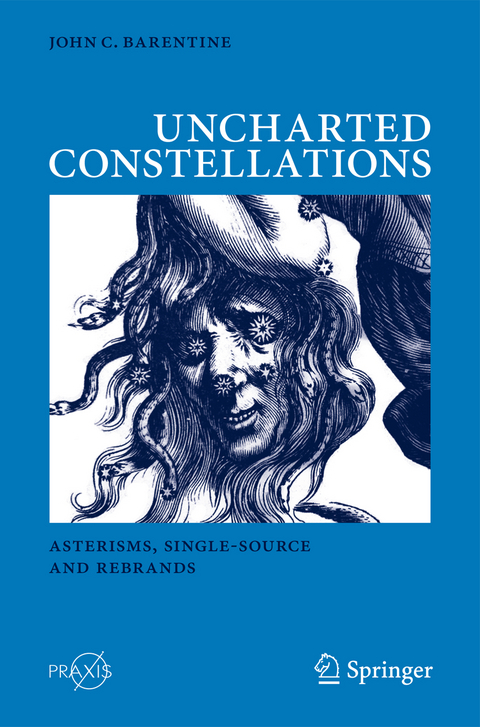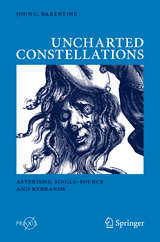Uncharted Constellations
Springer International Publishing (Verlag)
978-3-319-27618-2 (ISBN)
The 16 constellations found in this volume fall into one or more of three broad categories: asterims, such as the Big Dipper in Ursa Major; single-sourced constellations introduced on surviving charts by a cartographer perhaps currying the favor of sponsors; and re-brands, new figures meant to displace existing constellations, often for an ideological reason. All of them reveal something unique about the development of humanity's map of the sky.
John Barentine is a lifelong amateur astronomer, with formal education and experience in academic astronomy. He holds undergraduate and master's degrees in physics and astronomy, and received his Ph.D. in astronomy from the University of Texas at Austin in 2013. His dissertation work followed the path of atomic and molecular gas from star formation through the evolution of galaxies. Most of his doctoral research was published in the Astrophysical Journal, and in previously published articles in other academic outlets such as the Astronomical Journal and Astronomical Society of the Pacific Conference Series volumes. Previously, he was at Apache Point Observatory in New Mexico, where he was a staff scientist working on the Astrophysical Research Consortium 3.5-meter telescope and as an Observer for the Sloan Digital Sky Survey. For that work, John was honored in 2007 by the International Astronomical Union, which named the asteroid (14505) Barentine his honor. Now, he is the Program Manager for the International Dark-Sky Association. This work brings him into frequent contact with journalists and includes writing press releases. In 2006, he wrote a press release for an archaeoastronomy poster presented at a meeting of the AAS that went viral and resulted in worldwide media coverage as the "Barentine petroglyph". In addition to John's professional work, he writes an astronomy blog on Tumblr (strictlyastronomy.tumblr.com) and maintains an active presence on Twitter.
Part I: Introduction.- Part II: The Lost Constellations.- 2 Anser.- 3 Antino¨us.- 4 Argo Navis.- 5 Cancer Minor.- 6 Cerberus et Ramus Pomifer.- 7 Custos Messium.- 8 Felis.- 9 Gallus.- 10 Globus Aerostaticus.- 11 Honores Frederici.- 12 Jordanis.- 13 Machina Electrica.- 14 Mons Maenalus.- 15 Musca Borealis.- 16 Ocina Typographica.- 17 Psalterium Georgianum.- 18 Quadrans Muralis.p- 19 Rangifer.- 20 Rhombus.- 21 Robur Carolinum.- 22 Sagitta Australis.- 23 Sceptrum Brandenburgicum.- 24 Taurus Poniatovii.- 25 Telescopia Herschelii.- 26 Tigris.- 27 Triangulum Minus.- 28 Turdus Solitarius / Noctua.- Part III: Conclusion.- Part IV: Appendix: The Modern Constellations.
| Erscheinungsdatum | 08.10.2016 |
|---|---|
| Reihe/Serie | Popular Astronomy | Springer Praxis Books |
| Zusatzinfo | XVI, 222 p. 65 illus. |
| Verlagsort | Cham |
| Sprache | englisch |
| Maße | 155 x 235 mm |
| Themenwelt | Sachbuch/Ratgeber ► Natur / Technik ► Weltraum / Astronomie |
| Naturwissenschaften ► Geowissenschaften ► Geografie / Kartografie | |
| Naturwissenschaften ► Physik / Astronomie ► Astronomie / Astrophysik | |
| Schlagworte | Astronomy, Observations and Techniques • Big Dipper vs Ursa Major • Forgotten Constellations • Geographical Information Systems/Cartography • Historical Asterisms • History of Astronomical Nomenclature • History of Science • History of Star Cartography • History of star maps • Julius Schiller's Coelum Stellatum Christianum • Julius Schiller’s Coelum Stellatum Christianum • Physics and Astronomy • Popular Science in Astronomy • Single-sourced Constellations |
| ISBN-10 | 3-319-27618-2 / 3319276182 |
| ISBN-13 | 978-3-319-27618-2 / 9783319276182 |
| Zustand | Neuware |
| Haben Sie eine Frage zum Produkt? |
aus dem Bereich




